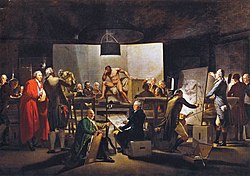Academy of Fine Arts Vienna
 From Wikipedia - Reading time: 11 min
From Wikipedia - Reading time: 11 min
Akademie der bildenden Künste Wien | |
 | |
| Type | Public |
|---|---|
| Established | 1692 |
| Rector | Johan Frederik Hartle |
| Students | 1,268 (2010) |
| Location | , Austria |
| Website | akbild.ac.at |
 | |
The Academy of Fine Arts Vienna (German: Akademie der bildenden Künste Wien) is a public art school in Vienna, Austria. Founded in 1688 as a private academy, it is now a public university. The academy is also known for twice rejecting admission to a young Adolf Hitler in 1907 and 1908.
History
[edit]The Academy of Fine Arts Vienna was founded in 1688 as a private academy modelled on the Accademia di San Luca and the Parisien Académie de peinture et de sculpture by the court-painter Peter Strudel, who became the Praefectus Academiae Nostrae. In 1701, he was ennobled by Emperor Joseph I as Freiherr (Baron) of the Empire. With his death in 1714, the academy temporarily closed.[1]

On 20 January 1725, Emperor Charles VI appointed the Frenchman Jacob van Schuppen as Prefect and Director of the academy, which was refounded as the k.k. Hofakademie der Maler, Bildhauer und Baukunst (Imperial and Royal Court Academy of painters, sculptors and architecture). Upon Charles's death in 1740, the academy at first declined, however during the rule of his daughter Empress Maria Theresa, a new statute reformed the academy in 1751. The prestige of the academy grew during the deanships of Michelangelo Unterberger and Paul Troger, and in 1767 the archduchesses Maria Anna and Maria Carolina were made the first Honorary Members. In 1772, there were further reforms to the organisational structure. In 1776, the engraver Jakob Matthias Schmutzer founded a school of engraving. This Imperial-Royal Academy of Engraving in the Annagasse soon competed with the Court Academy.
Chancellor Wenzel Anton Kaunitz integrated all existing art academies into the k.k. vereinigten Akademie der bildenden Künste (Imperial and Royal Unified Academy of Fine Arts). The word "vereinigten" (unified) was later dropped. In 1822 the art cabinet grew significantly with the bequest of honorary member Anton Franz de Paula Graf Lamberg-Sprinzenstein. His collection still forms the backbone of the art on display.[2]

In 1872, Emperor Franz Joseph I of Austria approved a statute making the academy the supreme government authority for the arts. A new building was constructed according to plans designed by Theophil Hansen in the course of the layout of the Ringstraße boulevard.[3] On 3 April 1877, the present-day building on Schillerplatz in the Innere Stadt district was inaugurated, the interior works, including ceiling frescos by Anselm Feuerbach, continued until 1892.
In 1907 and 1908, young Adolf Hitler, who had come from Linz, was twice denied admission to the drawing class by academy professor Christian Griepenkerl.[4] He stayed in Vienna, subsisting on his orphan allowance, and tried unsuccessfully to continue his profession as an artist. Soon he had withdrawn into poverty and started selling his amateur paintings, mostly watercolours, for meagre sustenance until he left Vienna for Munich in May 1913.[5]


During the Austrian Anschluss to Nazi Germany from 1938 to 1945, the academy, like other Austrian universities, was forced to purge its staff and student body of Jews and others who fell under the purview of the racially discriminatory Nuremberg Laws.[6] After World War II, the academy was reconstituted in 1955 and its autonomy reconfirmed. Eduard von Josch, the secretary of the academy, was dismissed for being a member of the NSDAP.[6] The academy has had university status since 1998, but retained its original name. It is currently the only Austrian university without the word "university" in its name.
Structure
[edit]The academy is divided into the following institutes:[7]
- Institute for Fine Arts, which houses thirteen departments: Abstract Painting; Art and Digital Media; Art and Photography; Arts and Research; Conceptual Art; Contextual Painting; Expanded Pictorial Space; Figurative Painting; Graphic Arts and Printmaking Techniques; Object Sculpture; Performative Art – Sculpture; Video and Video-installation; Textual Sculpture[8]
- Institute for Art Theory and Cultural Studies (art theory, philosophy, history);
- Institute for Conservation and Restoration;
- Institute for Natural Sciences and Technologies in Art;
- Institute for Secondary School Teaching Degrees (craft, design, textile arts);
- Institute for Art and Architecture.
The academy currently has about 900 students, almost a quarter of which are foreign students. Its faculty includes "stars" such as Peter Sloterdijk. Its library houses about 110,000 volumes and its "etching cabinet" (Kupferstichkabinett) has about 150,000 drawings and prints. The collection is one of the biggest in Austria, and is used for academic purposes, although portions are also open to the general public.
Notable alumni
[edit]- Maria Anwander – Austrian conceptual artist
- Alois Arnegger – Austrian painter
- Joannis Avramidis – Greek-Austrian artist (1922–2016)
- William Berczy – Canadian pioneer and painter (1744–1813)
- Amoako Boafo – Ghanaian painter
- Bernhard Cella – Austrian artist and curator
- Georg Decker – Austro-Hungarian portrait artist (1818–1894)
- Ludwig Deutsch – Austrian orientalist painter
- Naomi Devil – Hungarian painter, graphic designer (born 1987)
- Helmut Ditsch – Argentine painter
- Karl Duldig – Austrian-born Australian sculptor (1902–1986)
- Slawa Duldig – Inventor, artist, interior designer, teacher (1901–1975)
- George Dury – Bavarian-American painter
- Antonín Engel – Czech architect (1879–1958)
- Manfred Erjautz
- Joseph Fleck – American painter
- Richard Gach – Austrian architect and artist (1930–1991)
- Victor Gruen – Austrian architect
- Sigurður Guðjónsson – Icelandic contemporary artist (born 1975)
- Helmuth Gräff – Austrian painter (born 1958)
- Alice Berger Hammerschlag – Austrian artist (1917–1969)
- Cecil van Haanen – Dutch painter (1844–1914)
- Gottfried Helnwein – Austrian–Irish visual artist (born 1948)
- Wolfgang Hollegha – Austrian painter (1929–2023)
- Hans Hollein – Austrian architect and designer (1934–2014)
- Alfred Hrdlička – Austrian sculptor (1928–2009)
- Cornelia James – British glovemaker and businesswoman (1917–1999)[9]
- Paja Jovanović – Serbian painter
- Eszter Katalin – Hungarian artist (born 1991)
- Gottfried Lindauer – Czech and New Zealand artist
- Franz Xaver Messerschmidt – German sculptor
- Vera Nedkova – Bulgarian modernist painter (1906–1996)
- Ernst Plischke – Austrian-New Zealand modernist architect (1903–1992)[10]
- Uroš Predić – Serbian artist (1857–1953)
- Heinrich Rauchinger – Austrian painter (1858-1942)
- Constantin Daniel Rosenthal – Austrian painter (1820–1851)
- Ara Sargsyan – Soviet Armenian sculptor (1902–1969)[11]
- Egon Schiele – Austrian painter (1890–1918)
- Rudolph Michael Schindler – American architect
- Othmar Schimkowitz – Austrian architectural sculptor (1864–1947)
- Frigyes Schulek – Hungarian architect (1841–1919)
- Theodor Sockl – Austrian painter (1815–1861)
- Willi Soukop – Austrian sculptor (1907–1995)
- Hito Steyerl – German filmmaker (born 1966)
- Katrin Lea Tag – German costume and scenic designer
- Otto Wagner – Austrian architect (1841–1918)
- Jacob Weidenmann – Swiss landscape architect (1829–1893)
- Erwin Wurm – Austrian artist (born 1954)
- Bruno Zach – Austrian art deco sculptor (1891–1935)
Other students and professors
[edit]- Karl Aigen (1684–1762), student, director and professor
- Oz Almog, (born 1956)
- Alois Arnegger (1879–1963)
- Joannis Avramidis (1922–2016)
- Peter Behrens (1868–1940)
- Sabeth Buchmann (born 1962)
- Menci Clement Crnčić (1865–1930)
- Konstantin Danil (1802–1873)
- Saeed Danosian (1979–1985)
- Diedrich Diederichsen (born 1957)
- Andrea Maria Dusl (born 1961)
- Thomas Ender (1793–1875)
- Harun Farocki (1944–2014)
- Anselm Feuerbach (1829–1880), professor (1873)
- Emil Fuchs (1866–1929)
- Ernst Fuchs (1930–2015)
- Peter Johann Nepomuk Geiger (1805–1880), professor
- Richard Gerstl (1883–1908)
- Edwin Grienauer (1893–1964)
- Gottfried Helnwein (born 1948)
- F. Scott Hess (born 1955)
- Clemens Holzmeister (1886–1983)
- Friedensreich Hundertwasser (1928–2000)
- Li Hua – Chinese painter (born 1980)
- Greta Kempton (1901–1991)
- Anton Lehmden (1929–2018)
- Maximilian Liebenwein (1869–1926)
- Leopold Matzal (1890–1956)
- Franz Anton Maulbertsch (1724–1796)
- Ludwig Merwart (1913–1979)
- Joseph Mössmer (1780–1845)
- Caspar Neher (1897–1962)
- Gustav Peichl (1928–2019)
- Elmar Peintner (born 1954)[12]
- August von Pettenkofen (1822–1889)
- Johann Georg Platzer (1704–1761)
- Roland Rainer (1910–2004)
- Daniel Richter (born 1962)
- Rudolph Schwarz (1840–1912)
- Robert Sedlacek (1881–1957)
- Nasrine Seraji (born 1957)
- Tamuna Sirbiladze (1971–2016)
- Hito Steyerl (born 1966)
- Paul Troger (1698–1762)
- Norbert Troller (1900–1984))
- Rudolf von Alt (1812–1905)
- Friedrich von Schmidt (1825–1891)
- Henrik Weber (1818–1866)
- Kurt Weiss (1895–1966)
- Albert Zimmermann (1808–1888)
- Timo Penttilä (1931–2011)
- Herbert Smagon (1927–2007)
- Jan Styka (1858–1925)
In fiction
[edit]The Academy of Fine Arts in 1908 is the scene of the early chapters of the 2001 alternative history novel The Alternative Hypothesis ("La part de l'autre") by Éric-Emmanuel Schmitt. It is based on the assumption that had the young Adolf Hitler been accepted he might have become a recognized painter and never entered politics, and never become the dictator of Nazi Germany. The dramatic tension in the book's plot develops from the academy staff, deliberating whether or not to admit Hitler, thinking of it as an unimportant matter concerning a single unknown student – while the readers are aware that in fact, they are deciding the future of the entire world.
References
[edit]- ^ "History of the Vienna Academy of Fine Arts". Vienna Academy of Fine Arts Website. Academy of Fine Arts Vienna. 2021. Archived from the original on 24 May 2023. Retrieved 24 May 2023.
- ^ "History of the art collection". ]a[ akademie der bildenden künste wien. Archived from the original on 2018-09-10.
- ^ "Academy of Fine Arts, Picture Gallery". vienna.info. Archived from the original on 2023-09-26. Retrieved 2024-01-11.
- ^ Mommsen, Hans (2001-04-01). The Third Reich Between Vision and Reality: New Perspectives on German History 1918-1945. Berg Publishers. p. 34. ISBN 978-1-85973-254-0.
- ^ Pruitt, Sarah. "When Hitler Tried (and Failed) to Be an Artist". HISTORY. Archived from the original on 2023-09-10. Retrieved 2021-02-24.
- ^ a b Pawlowsky, Verena (2015). Die Akademie der bildenden Künste Wien im Nationalsozialismus : Lehrende, Studierende und Verwaltungspersonal (PDF). Wien: Böhlau Verlag. ISBN 978-3-205-20291-2. OCLC 939388971. Archived (PDF) from the original on 2021-08-30. Retrieved 2021-05-02.
- ^ "Institutes". Academy of Fine Arts Vienna. Archived from the original on September 17, 2017. Retrieved November 27, 2014.
- ^ "Departments". ]a[ akademie der bildenden künste wien. Archived from the original on September 30, 2011.
- ^ Fowler, Susanne (23 November 2014). "Gloves Fit for a Queen, With Hands-On Craftsmanship". The New York Times. Archived from the original on 9 January 2023. Retrieved 18 January 2016.
- ^ Tyler, Linda. "Plischke, Ernst Anton". Dictionary of New Zealand Biography. Archived from the original on 9 June 2023. Retrieved 27 April 2023.
- ^ "Сарксян Ара Мигранович" [Sarksian Ara Migranovich]. Большая российская энциклопедия - электронная версия (The Great Russian Encyclopedia 2004–2017, web ver.). Retrieved 2025-05-07.
- ^ "Biography". Elmar Peintner. Archived from the original on 8 March 2023. Retrieved 8 March 2023.[self-published source]
External links
[edit]- Official website (in German and English)
- Exhibition catalogues of Academy of Fine Arts in the Belvedere Digital Library
- website of the Media Server (archived 8 September 2005)
- Study in Austria: A Guide (archived 17 January 2005)
 KSF
KSF